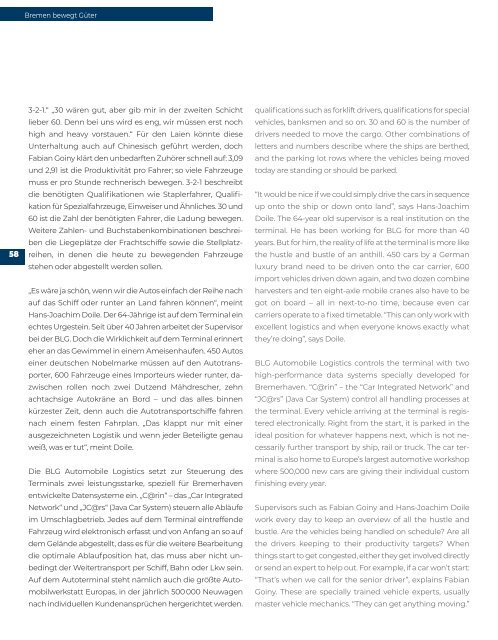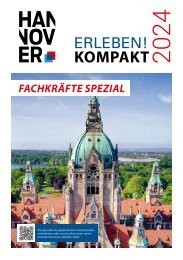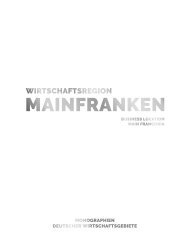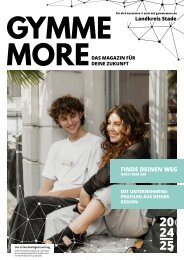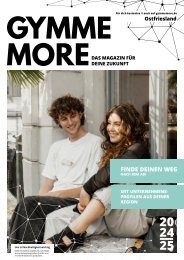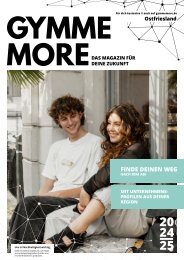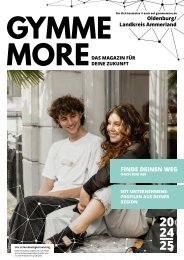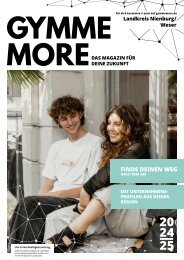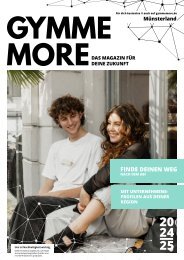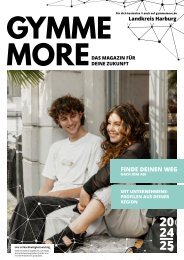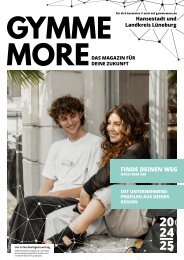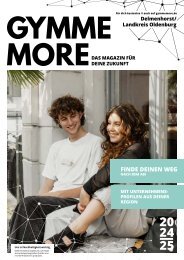Bremen bewegt 2019
Erfolgreiche ePaper selbst erstellen
Machen Sie aus Ihren PDF Publikationen ein blätterbares Flipbook mit unserer einzigartigen Google optimierten e-Paper Software.
<strong>Bremen</strong> <strong>bewegt</strong> Güter<br />
58<br />
3-2-1.“ „30 wären gut, aber gib mir in der zweiten Schicht<br />
lieber 60. Denn bei uns wird es eng, wir müssen erst noch<br />
high and heavy vorstauen.“ Für den Laien könnte diese<br />
Unterhaltung auch auf Chinesisch geführt werden, doch<br />
Fabian Goiny klärt den unbedarften Zuhörer schnell auf: 3,09<br />
und 2,91 ist die Produktivität pro Fahrer; so viele Fahrzeuge<br />
muss er pro Stunde rechnerisch bewegen. 3-2-1 beschreibt<br />
die benötigten Qualifikationen wie Staplerfahrer, Qualifi -<br />
kation für Spezialfahrzeuge, Einweiser und Ähnliches. 30 und<br />
60 ist die Zahl der benötigten Fahrer, die Ladung bewegen.<br />
Weitere Zahlen- und Buchstabenkombinationen beschreiben<br />
die Liegeplätze der Frachtschiffe sowie die Stellplatz -<br />
reihen, in denen die heute zu bewegenden Fahrzeuge<br />
stehen oder abgestellt werden sollen.<br />
„Es wäre ja schön, wenn wir die Autos einfach der Reihe nach<br />
auf das Schiff oder runter an Land fahren können“, meint<br />
Hans-Joachim Doile. Der 64-Jährige ist auf dem Terminal ein<br />
echtes Urgestein. Seit über 40 Jahren arbeitet der Supervisor<br />
bei der BLG. Doch die Wirklichkeit auf dem Terminal erinnert<br />
eher an das Gewimmel in einem Ameisenhaufen. 450 Autos<br />
einer deutschen Nobelmarke müssen auf den Autotrans -<br />
porter, 600 Fahrzeuge eines Importeurs wieder runter, dazwischen<br />
rollen noch zwei Dutzend Mähdrescher, zehn<br />
achtachsige Autokräne an Bord – und das alles binnen<br />
kürzester Zeit, denn auch die Autotransportschiffe fahren<br />
nach einem festen Fahrplan. „Das klappt nur mit einer<br />
ausgezeichneten Logistik und wenn jeder Beteiligte genau<br />
weiß, was er tut“, meint Doile.<br />
Die BLG Automobile Logistics setzt zur Steuerung des<br />
Terminals zwei leistungsstarke, speziell für Bremerhaven<br />
entwickelte Datensysteme ein. „C@rin“ – das „Car Integrated<br />
Network“ und „JC@rs“ (Java Car System) steuern alle Abläufe<br />
im Umschlagbetrieb. Jedes auf dem Terminal eintreffende<br />
Fahrzeug wird elektronisch erfasst und von Anfang an so auf<br />
dem Gelände abgestellt, dass es für die weitere Bearbeitung<br />
die optimale Ablaufposition hat, das muss aber nicht un -<br />
bedingt der Weitertransport per Schiff, Bahn oder Lkw sein.<br />
Auf dem Autoterminal steht nämlich auch die größte Automobilwerkstatt<br />
Europas, in der jährlich 500 000 Neuwagen<br />
nach individuellen Kundenansprüchen hergerichtet werden.<br />
qualifications such as forklift drivers, qualifications for special<br />
vehicles, banksmen and so on. 30 and 60 is the number of<br />
drivers needed to move the cargo. Other combinations of<br />
letters and numbers describe where the ships are berthed,<br />
and the parking lot rows where the vehicles being moved<br />
today are standing or should be parked.<br />
“It would be nice if we could simply drive the cars in sequence<br />
up onto the ship or down onto land”, says Hans-Joachim<br />
Doile. The 64-year old supervisor is a real institution on the<br />
terminal. He has been working for BLG for more than 40<br />
years. But for him, the reality of life at the terminal is more like<br />
the hustle and bustle of an anthill. 450 cars by a German<br />
luxury brand need to be driven onto the car carrier, 600<br />
import vehicles driven down again, and two dozen combine<br />
harvesters and ten eight-axle mobile cranes also have to be<br />
got on board – all in next-to-no time, because even car<br />
carriers operate to a fixed timetable. “This can only work with<br />
excellent logistics and when everyone knows exactly what<br />
they’re doing”, says Doile.<br />
BLG Automobile Logistics controls the terminal with two<br />
high-performance data systems specially developed for<br />
Bremerhaven. “C@rin” – the “Car Integrated Network” and<br />
“JC@rs” (Java Car System) control all handling processes at<br />
the terminal. Every vehicle arriving at the terminal is regis -<br />
tered electronically. Right from the start, it is parked in the<br />
ideal position for whatever happens next, which is not ne -<br />
cessarily further transport by ship, rail or truck. The car ter -<br />
minal is also home to Europe’s largest automotive workshop<br />
where 500,000 new cars are giving their individual custom<br />
finishing every year.<br />
Supervisors such as Fabian Goiny and Hans-Joachim Doile<br />
work every day to keep an overview of all the hustle and<br />
bustle. Are the vehicles being handled on schedule? Are all<br />
the drivers keeping to their productivity targets? When<br />
things start to get congested, either they get involved directly<br />
or send an expert to help out. For example, if a car won’t start:<br />
“That’s when we call for the senior driver”, explains Fabian<br />
Goiny. These are specially trained vehicle experts, usually<br />
master vehicle mechanics. “They can get anything moving.”


